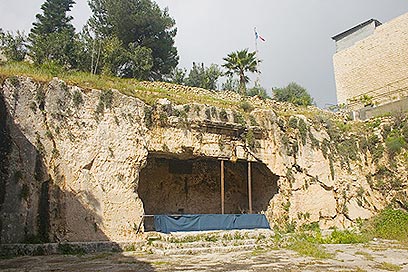
The Tomb of the Kings
Photo: Ron Peled

The Tomb of the Kings
Photo: Ron Peled
Imagine a magnificent burial plot covering several acres with an enormous courtyard at the entrance, many pyramids and decorations, stairs that lead to a plaza, a burial cave with an impressive burial stone, and wells and channels that bring rain waters to them. Now imagine that this is all carved in stone and has been in Jerusalem for 2,000 years.
The Tomb of the Kings, considered one of the largest and most luxurious tombs in the area, has long been popular with tourists. Some believed it should have been considered one of the wonders of the ancient world.
Today the tomb is owned by the French, and a French flag flies over it. Enter the site through a metal door on the corner of Nablus Road and Salah a-Din Street, near the American Colony Hotel and the Justice Ministry. The tomb has no formal visiting hours, so just knock hard on the door or ring the bell. Entrance is NIS 3.
Robbers of the ancient grave
Carved in the steps are two channels for rainwater, which flows into a ritual bath. Theodor Herzl had himself photographed at the bottom of the steps when he visited with his retinue in the fall of 1898.
At the bottom of the stairs on the left an arched stone gate leads to a square courtyard. The courtyard was hewn to a depth of nearly 30 feet, and some 20,000 tons of stone were removed to create it. Three pyramids are said to have once adorned the tomb’s facade above the opening. The tomb has no fewer than 48 graves, but over the years grave robbers plundered the sarcophagi.

The Tomb of the Kings (Photo: Ron Peled)
To the right of the entrance is a tunnel where you can crawl for a few feet until you reach the burial chamber. To the right of the entrance opposite it you will see additional chambers. Bring a flashlight with you.
Josephus, who described the tomb in the first century C.E., tells of a queen named Helena who came to Jerusalem from Adiabene in Kurdistan in northern Iraq. Her family converted to Judaism and built a palace, apparently in the area of the City of David, at the end of the Second Temple Period. They also donated treasures to the Temple and helped the people in times of famine.
Josephus adds that Helena’s son Monobaz had her remains and those of his brother buried at a distance of “three stadia from Jerusalem,” and that this burial cave belongs to Helena and her family. It was medieval Europeans who mistakenly identified the tomb as belonging to the Kings of Judah. The kings’ burial place is mentioned in the Bible, but it has never been found.
In 1863 French archaeologist Felicien de Saulcy, with the permission of the Turkish sultan, began to excavate the tomb while he was also searching for the tablets of the law at Mount Nebo and conducting other excavations near Jerusalem’s Gate of Mercy. As early as 1847 the Turkish governor gave an order to search for treasures in the tomb, but no treasures were ever found.
The tomb might have been plundered before that, or perhaps there were no treasures hidden there. Conrad Schick, a German and one of the great archeologists of 19th-century Jerusalem, also worked on the site, drawing a precise map of the tomb.
De Saulcy found sarcophagi in the tomb, one of which had a Hebrew inscription, “Queen Tzaddah,” which was perhaps Queen Helena’s name in Greek. De Saulcy was convinced that this was the sarcophagus of the wife of Zedekiah, the last king of Judah.
When human bones were found in another sarcophagus the local Jewish community got involved and Chief Rabbi Chaim David Chazan complained to Sir Moses Montefiore and others, who persuaded the Ottoman rulers to stop the excavations. De Saulcy smuggled out some artifacts, including sarcophagi, which can today be see in the Louvre in Paris.
The French and the righteous
In 1864 French-Jewish banker Isaac Péreire unsuccessfully attempted to purchase the site in order to preserve it. In the 1870s another French Jew, Amalya Bertrand, paid 30,000 francs for it, and the site was registered as French territory under the trusteeship of the French consul.
Following the purchase of the tomb Bertrand declared: “I am of the firm opinion that this property, the field and the burial cave of the kings, will become the land in perpetuity of the Jewish community, to be preserved from desecration and abomination, and will never again be damaged by foreigners.”
Bertrand built a wall around the tomb and a guard post. While the work was being carried out the graves were robbed once again, and the Jews of the city moved the bones they found to the nearby tomb of Simon Hatzadik (Simon the Righteous), a Second Temple priest.
In 1886 the Tomb of the Kings was given by the Bertrand family as a gift to the French government, and since then the French flag has flown over it. In recent years attempts have been made to prove that the site belongs to the State of Israel.
The Jews of Jerusalem used to call the tomb “the tomb of Kalba Savua”—a wealthy Jew from Jerusalem who lived in the Second Temple period and was Rabbi Akiva’s father-in-law—because they believed he was buried there. Another tradition says that it is the tomb of Caleb son of Jephunneh, one of the Twelve Spies in the Bible. The tomb has also been called “the tomb of the Sultans.”
On Lag Ba’omer the Jews of the city used to visit the tomb, light candles, and pray for the ascent of the souls of the righteous who, according to tradition, were buried there.















